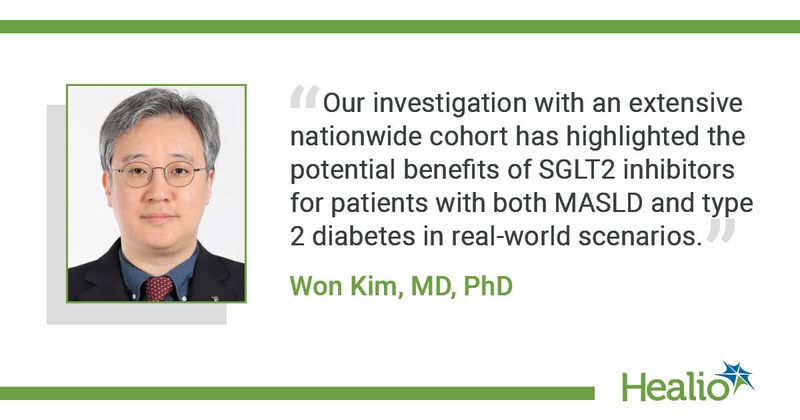SGLT2 inhibitors surpassed other antidiabetics as ‘viable option’ for MASLD in diabetes
Click Here to Manage Email Alerts
Key takeaways:
- Sodium-glucose cotransporter 2 inhibitors were linked with higher likelihood of MASLD regression.
- Lower incidence of adverse liver-related outcomes also was reported compared with other oral antidiabetic drugs.
Sodium-glucose cotransporter 2 inhibitors were associated with a higher likelihood of disease regression among patients with concomitant metabolic dysfunction-associated steatotic liver disease and type 2 diabetes, data showed.
“Over a quarter of people worldwide suffer from MASLD, which can cause severe health issues like cirrhosis and liver cancer, yet no medications have received FDA approval for therapeutic purpose,” Won Kim, MD, PhD, associate professor in the department of internal medicine at Seoul National University College of Medicine, told Healio. “Obesity and insulin resistance are shared risk factors between MASLD and type 2 diabetes, and MASLD affects 55.5% of those who have been diagnosed with type 2 diabetes.”

He added: “Inspired by preliminary studies demonstrating that some oral antidiabetic drugs may ameliorate fatty liver, our research group was eager for a thorough comparison of all potentially beneficial oral antidiabetic drugs in a real-world setting using a nationwide cohort.”
Using the National Health Information Database, Kim and colleagues investigated outcomes of 80,178 patients (mean age, 58.5 years; 53.6% men) with MASLD and type 2 diabetes, who were treated with oral antidiabetic drugs combined with metformin for at least 80% of 90 consecutive days. Most patients received a dipeptidyl peptidase-4 (DPP-4) inhibitor (n = 55,324), followed by sulfonylurea (n = 13,193), sodium-glucose cotransporter 2 (SGLT2) inhibitor (n = 9,470) and thiazolidinedione (n = 2,191).
The primary studied outcome was MASLD regression, assessed by the fatty liver index and composite liver-related outcomes.
According to results in JAMA Internal Medicine, during 219,941 person-years of follow-up, researchers reported MASLD regression among 4,102 patients, with higher incidence of regression for SGLT2 inhibitors (adjusted subdistribution hazard ratio [ASHR] = 1.99; 95% CI, 1.75-2.27), thiazolidinediones (ASHR = 1.7; 95% CI, 1.41-2.05) and DPP-4 inhibitors (ASHR = 1.45; 95% CI, 1.31-1.59) compared with sulfonylureas.
“SGLT2 inhibitors were distinguished by their association with fatty liver improvement, surpassing other [oral antidiabetic drugs] known for their potential benefits in MASLD,” Kim said.
In individual drug comparisons, SGLT2 inhibitors had “the most favorable outcomes” and higher regression rates vs. thiazolidinediones (ASHR = 1.4; 95% CI, 1.12-1.75) and DPP-4 inhibitors (ASHR = 1.45; 95% CI, 1.3-1.62).
Further, although SGLT2 inhibitors made “no significant difference” in liver-related outcomes vs. DPP-4 inhibitors (ASHR = 0.67; 95% CI, 0.33-1.35) or thiazolidinediones (ASHR = 0.7; 95% CI, 0.27-1.84), only SGLT2 inhibitors were significantly associated with reduced incidence of adverse liver-related outcomes compared with sulfonylureas (ASHR = 0.37; 95% CI, 0.17-0.82).
“Metformin is currently the primary oral antidiabetic drug for managing type 2 diabetes in patients with MASLD, while SGLT2 inhibitors are specifically advised for those with cardiovascular diseases,” Kim said. “While current clinical guidelines do not specify a preferred oral antidiabetic drug for patients with type 2 diabetes and MASLD, recommending SGLT2 inhibitors could be a viable option to alleviate fatty liver and reduce the likelihood of liver-related outcomes in these patients.”
He continued: “Our investigation with an extensive nationwide cohort has highlighted the potential benefits of SGLT2 inhibitors for patients with both MASLD and type 2 diabetes in real-world scenarios. However, the retrospective nature of the study might impose interpretive restrictions. Implementing prospective research and clinical trials will bolster the reliability of our research findings.”
SGLT2 inhibitors were distinguished by their association with fatty liver improvement, surpassing other OADs known for their potential benefits in NAFLD.

